Here’s what’s new in the latest ArcGIS release—in mapping, visualization, analytics, and more.

ArcGIS Pro
The latest release of Esri’s powerful, feature-packed desktop software is here and it delivers a lot of what you’ve asked for. With every release of ArcGIS Pro, there are many useful, interesting and often fun new features to help you get your work done. ArcGIS Pro also provides new ways to improve mapping and spatial analysis efficiency and productivity with faster, easier methods. ArcGIS Pro 2.5 continues its mission of bringing you the new tools, workflows and capabilities requested by the community and optimized for the modern GIS professional. We’ve created a video of the new features in ArcGIS Pro 2.5.
Here are a few of the new items you can expect to find in ArcGIS Pro 2.5:
Mapping and Visualization
- Color management settings to ensure colors are rendered consistently across devices
- Exportability to the Adobe Illustrator Exchange (.AIX) file format to bring maps into Adobe Illustrator for graphic design and map finishing
- New map projections
- Overprint capability for symbol layers to avoid registration errors in printing
Analysis
- Python notebooks integrated into ArcGIS Pro for data science workflows
- Ability to schedule analytical tools to run later or with recurrence
- Improvements in performance especially when working in large projects
- New workflows for business analytics tasks, such as site evaluation and target marketing
Data management
- Meta data automation
- Manage distributed data using geodatabase replication workflows to create and manage replicas and sync changes using traditional versioning
- Updates for authoring indoor maps for use with ArcGIS Indoors
- Ability to turn Building Information Management (BIM) file workspaces into a geodatabase feature dataset
Map production
- New tools and enhancements for aviation and maritime mapping and charting, defense mapping, pipeline referencing, and production mapping.
Learn more here. Quick note: For ArcMap users, ArcGIS Pro 2.5 has delivered over 60 user requested enhancements, many of them being ArcMap equivalency requests. Visit the ArcGIS Ideas site to view the status of a request or to submit a new idea! If you are new to ArcGIS Pro, we invite you to download a free trial today.
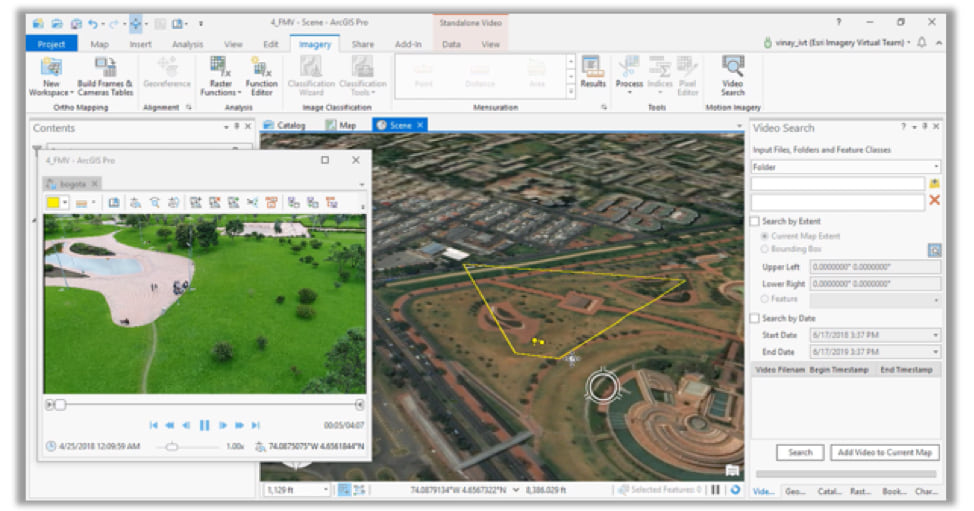
ArcGIS Image Analyst
The latest release of ArcGIS Image Analyst in ArcGIS Pro 2.5 includes broader support image analysis with expanded deep learning, FMV, and multidimensional workflows.
Improved deep learning—Users will be able to natively train deep learning models using geoprocessing tools in ArcGIS Pro! This enables seamless end-to-end workflows in ArcGIS Pro, once relevant deep learning libraries such as PyTorch, Fast.ai and Torchvision are installed. Additional deep learning geoprocessing tools have been added to train a deep learning model, classify objects using inferencing tool. The ability to run deep learning at scale to create and share a deep learning package (DLPK) to ArcGIS Enterprise is added. New labelling user experience designed specifically for deep learning workflows is supported. A better user experience to review deep learning results, and edit classes as required is added.
Enhancements to raster functions—Ten new raster functions have been added, including distance, multidimensional, and hydro, enabling analysts to design and run targeted workflows for distance modeling, hydrological modeling and multidimensional analysis. Several new geoprocessing tools for multidimensional analysis (Find Argument Statistics, Generate Trend Raster, and Predict Using Trend Raster) have been added.
Improvements to FMV—Improvements to motion video support, have been added to better manage and interactively use video with embedded geospatial metadata. Users can experience enhanced video streaming in the video player. Users can now view video data in multiple video players and synchronize the video for comparison and analysis. Users can now measure length, area, and height from videos. Now included is a video feed manager for users to list and manage videos you have added to a project.
Enhancement to Arcpy API—New methods and properties have been added to the Python Raster object for multidimensional rasters. New functions to support multidimensional raster management and display (Clip, Render, Merge) have been added.
Improvements to multidimensional analysis—The multidimensional analysis toolset has three new geoprocessing tools (Find Argument Statistics, Generate Trend Raster, and Predict Using Trend Raster). When charting multidimensional data, Temporal Profile has been enhanced to support areas of interest with spatial aggregation and charting trends.
Pixel Editor enhancements—New operations have been added to the Pixel Editor. Users can now customize processing with the ability to apply a raster processing template (.rft.xml) to the selected region. Users now have support to interpolate pixel values from the edges.
Drone2Map for ArcGIS
Camera model editor improvements—Users are now able to edit existing cameras in the internal camera database and store the modified camera models in the user camera database. Using the camera model editor allows users to input known, high-accuracy parameters when applicable and keep those values throughout processing.
Control enhancements—Users now have a better way to manage project control with the ability to view properties of each control point, filter based on type of control, and launch the links editor all with a few button clicks. Users will now be able to create and link manual tie points to images.
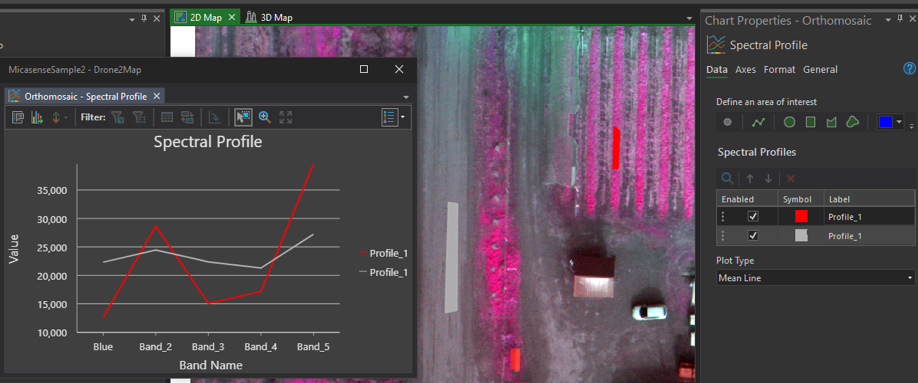
Improvements for elevation models—Drone2Map users are now able to publish their own custom surfaces on ArcGIS Online or ArcGIS Enterprise for either bare ground DTM or top surface DSM. Users can also add their own elevation surface into the to ensure that any 3D views incorporate the authoritative elevation surface. Users are now able to generate cross-sectional elevation profiles in any Drone2Map projects that are processed to create output surfaces (DSM and/or DTM). For users with multispectral cameras, Drone2Map also allows extraction of spectral profiles (defined by point samples, linear pixel samples, or 2D areas of interest) to support detailed analysis of vegetation or other landcover surface types.
Additional software enhancements have been made—Indices created from multispectral imagery products are now colorized by default. The inspection template has been added to all users who wish to create projects that are focused on inspecting, annotating, and sharing raw drone images. Browse performance has been improved when browsing folders and files on disk. Users can expect improved the performance of reading and extracting Exif data from drone images. This improvement significantly reduces the amount of time required to create a project.
ArcGIS for Maritime
The latest release of ArcGIS Pro simplifies the editing of complex attributes with the new S-100 Attribute Editor. Additionally, Information and Feature Associations can now be managed and created using the new Association Manager. Editing is further simplified with the Display Scale control, which allows you to easily set the minimum and maximum scales for newly created features. These capabilities are all available from the new Maritime ribbon in ArcGIS Pro 2.5.
ArcGIS Data Reviewer
This release brings new capabilities for automating quality control workflows. Several automated validation checks used to identify features that do not meet data quality requirements can now be configured as Attribute Rules. These checks include those which assess a feature’s integrity, attribution or spatial relationship with other features. By leveraging validation services in ArcGIS Server 10.8, features which fail validation can be reviewed and corrected using ArcGIS Pro 2.5 or through custom web applications.
Esri Redistricting
The Esri Redistricting web app has several new features ahead of the 2020 Census cycle, including improved plan creation workflows, a new streamlined Themes function for demographic overlays, dual monitor/pop-out window support, and capabilities to create multi-county plans, or plans based on partial selection areas of one state, county or region.
Esri Production Mapping / Esri Defense Mapping
This release for Esri Production Mapping and Esri Defense Mapping introduces new production workflows for data editing, quality control, and cartography. Workflow tools have been added to the Workflow toolset and a new tool for extracting data from an area of interest has been added to the Data Management toolset.
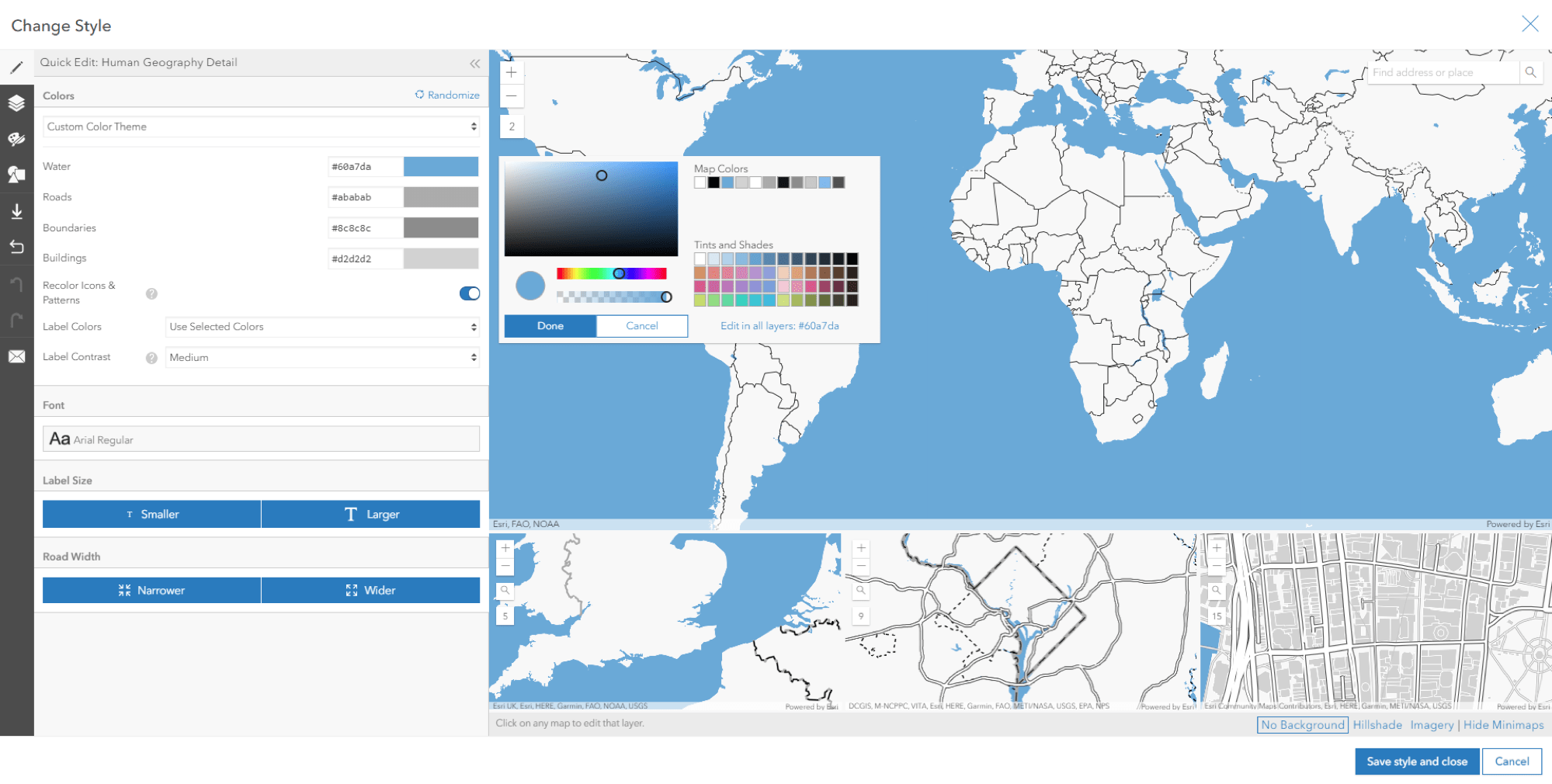
ArcGIS Enterprise
Highlights of the ArcGIS Enterprise 10.8 release include new administrative settings in the Enterprise portal, new options for publishing and data, new apps, updates to ArcGIS Enterprise Sites, and additional enhancements throughout the product. Updates include:
- A read-only setting for ArcGIS Enterprise to prevent downtime and data loss.
- An informational banner for the header and footer of your Enterprise portal as well as an access notice when users visit your environment.
- New Vector Tile Style editor for customizing the look of your vector tiles.
- Faster rendering and reduced publishing time for hosted feature layers.
- New webhooks trigger events around user types and roles.
- Many group enhancements, including administrative groups.
- Updated resources for Architecting Your Deployment, as well as an updated Functionality Matrix.
- Utility Network and Parcel Fabric user type extensions now available.
Don’t forget ArcGIS Enterprise 10.8 is a short-term support release. ArcGIS Enterprise 10.8.1, planned for release later in 2020, will be a long-term support release for customers looking for several years of support and updates. Learn more about what’s new at ArcGIS Enterprise 10.8.
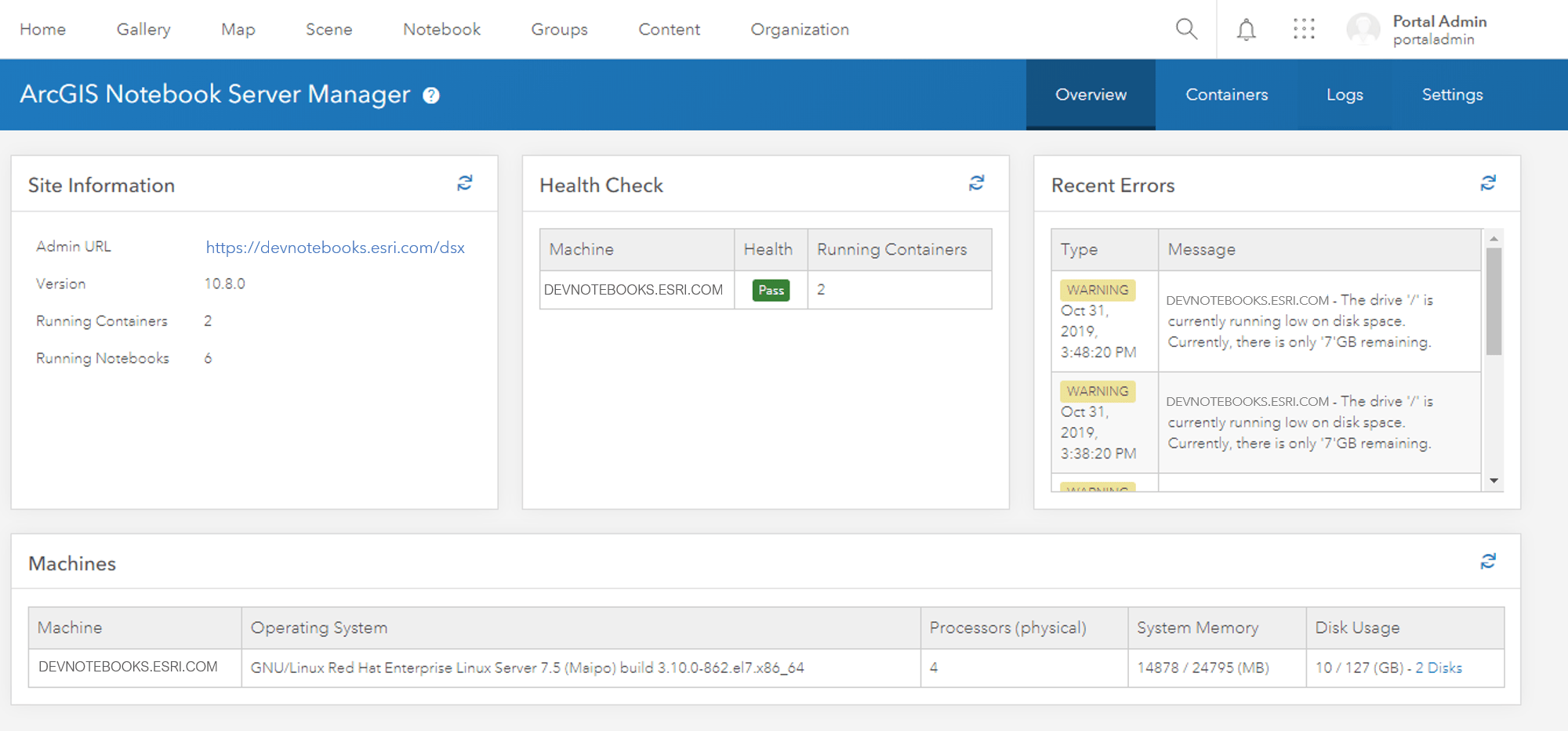
ArcGIS Notebook Server
The ArcGIS Notebook Server combines spatial analysis and data science within the familiar interface of ArcGIS by leveraging Python and Jupyter. Jumpstart advanced analytical capabilities, boost productivity via workflow automation and more.
In 10.8, ArcGIS Notebook Server offers new enhancements, tools and bug fixes with some notable developments as described below:
- ArcGIS Notebook Server Manager—The new ArcGIS Notebook Server Manager application is an intuitive graphical interface, built into the portal, that can be used to manage common administrative tasks used in your site. Read the blog to learn more.
- Collapsible cells—Sections of ArcGIS Notebooks can now be collapsed in the notebook editor, enabling easier navigation of lengthy notebooks and efficient in-notebook analysis storytelling.
- Notebook automation—Automate notebook execution by using the new ‘Execute Notebook’ operation in the ArcGIS Notebook Server Administrator directory, which opens a new container and runs an entire notebook without needing the notebook author to manually execute each cell. The Execute Notebook API allows notebooks to run using task schedulers. Learn more about automated notebook execution.
- See what else is new in ArcGIS Notebook Server 10.8.
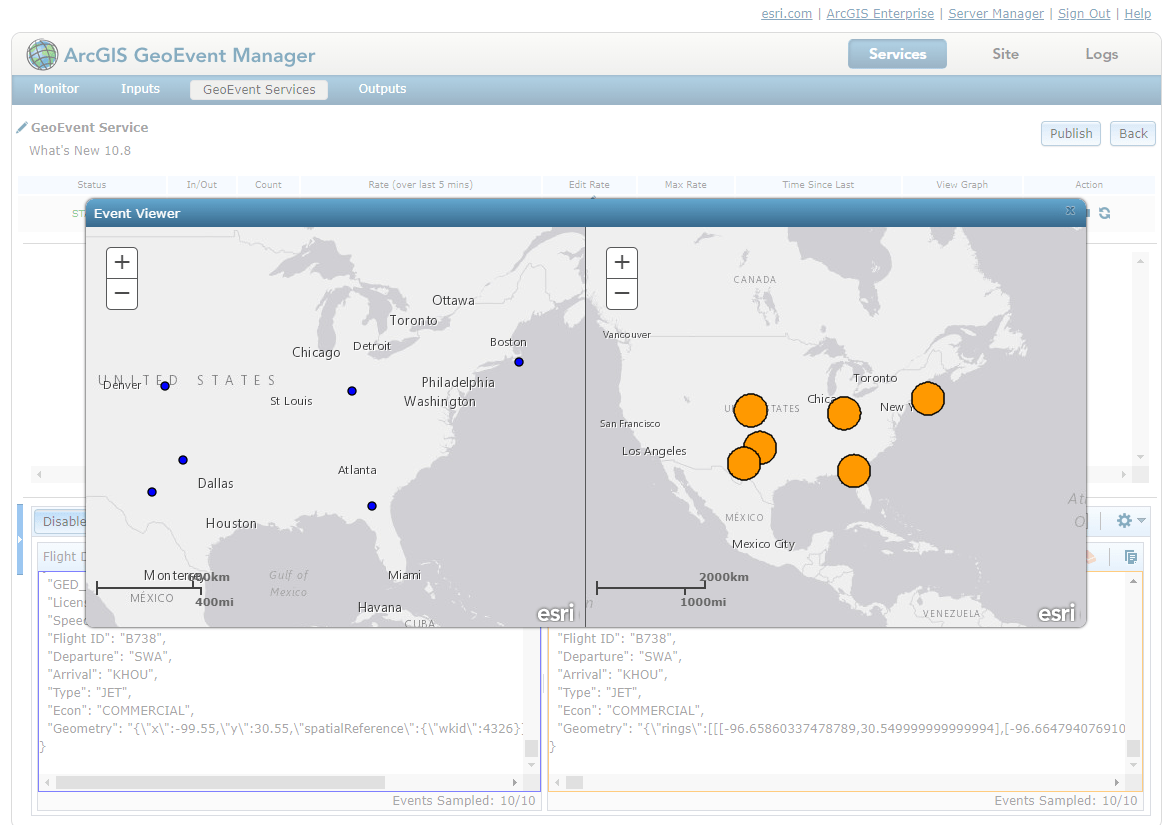
ArcGIS GeoEvent Server
ArcGIS GeoEvent Server at 10.8 includes stability enhancements as well as improved functionality and usability. Here are some highlights:
- The usability enhancements in GeoEvent Manager’s service designer include the ability to create and add new input connectors and output connectors; the ability to edit the connectors’ properties; and access to edit key GeoEvent Server settings such as GeoEvent Definitions, geofences, and data stores.
- GeoEvent Sampler is a utility embedded in the service designer that lets you sample and view GeoEvents as delimited text or prettified JSON.
- Expanded help for available processors.
- Input and output connectors are now in a stopped state by default.
ArcGIS GeoAnalytics Server
At the 10.8 release, new analytics capabilities and broader flexibility for users to use their big data storage were added to GeoAnalytics Server. Some of the most significant enhancements for this release include new analysis tools:
- Find dwell locations – this tool enables determination of dwell locations from time-sequential points in a track. This helps to analyze locations where moving people, vehicles or assets stayed for a certain threshold amount of time.
- Enhanced point clusters tool – in 10.8, the Find Point Clusters tool now lets users discover point clusters based on spatiotemporal distribution.
ArcGIS Image Server
ArcGIS Image Server 10.8 release includes broader support for data formats and sensor types, improved image hosting and analysis capabilities, and enhancements to ArcGIS Ortho Maker.
Better support for multidimensional data—Support for multidimensional CRF files, an optimized format for storing and accessing multidimensional data such as multi-variant temporal datasets is available. We also added multidimensional analysis tools to support anomaly detection and predictive modeling workflows commonly used by the scientific community.
Improved image hosting—Support for hosting additional raster types, allowing organizations to host more complex image data have been added. Users can also take advantage of processing options such as building footprints and color correction that were previously only available with ArcGIS Pro.
More raster functions in the ArcGIS Enterprise Map Viewer—The Map Viewer included with ArcGIS Enterprise 10.8 now supports more analysis capabilities when used with ArcGIS Image Server. The raster function editor has been extended to include more functions including category filters, hydrological analysis, and multidimensional analysis tools. This makes imagery analysis capabilities more accessible to end users.
Improved deep learning capabilities—Deep learning was supported at ArcGIS Image Server 10.7, but it was limited to a single GPU per machine. Starting at ArcGIS Image Server 10.8, Users can use single node parallel processing across multiple GPUs to speed up deep learning workflows. Additional deep learning training and linear spectral unmixing capabilities have been added. The deep learning tools now support image space, allowing users to apply deep learning to oblique imagery. The process of setting up deep learning environments has also been significantly simplified. Together, these improvements make ArcGIS Image Server a more robust platform for deep learning using imagery.
Enhancements to Ortho Maker—Ortho Maker now lets users reference datasets in a registered data store, which can help improve the efficiency of their workflows. Support for additional multispectral cameras (RedEdge and Altum) have been added to give users greater flexibility to use their sensors of choice.
ArcGIS for INSPIRE
In the latest release of ArcGIS for INSPIRE, Esri has added the Bio-geographical Regions (BR) data theme and ElevationVectorElements application schema of Elevation (EL) data theme. Support has also been added to the INSPIRE Geoportal for creating and updating metadata following the INSPIRE metadata technical guidance TG 2.0.
ArcGIS Living Atlas of the World
ArcGIS Living Atlas of the World includes curated maps, apps, and data layers from Esri and the global GIS user community that support your work. Visit the Living Atlas website, where you can browse content, view the blog, and learn how you can contribute. Looking for the latest American Community Survey (ACS) data? ArcGIS Living Atlas of the World now includes 78 new data layers that cover 89 different ACS tables from the newest 2014-2018 ACS estimates. Ready-to-use in ArcGIS, these layers cover topics such as housing, population, employment, income, race, age, insurance, education, veteran status, internet connectivity, and more.
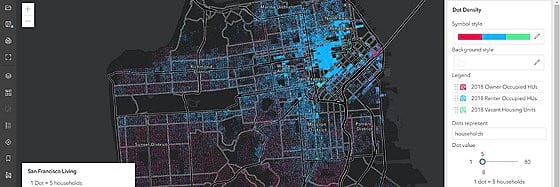
ArcGIS Online
ArcGIS Online was updated on December 19. Key improvements include:
- Improved Sharing Interfaces: When sharing content, you will notice an updated interface that guides you through the process. First, you select a sharing level (Owner, Organization, Everyone) and then, in a separate window, you can filter and select groups to share your content with.
- Updated Organization Settings Page: The organization settings experience has been improved with a new design, the ability to search for the setting you want, and discovery of individual settings. Administrators can more easily navigate the organization settings tab by searching for a setting, or using the side navigation links. In addition, changes are now saved automatically.
- New Organizational Notices: There is a new way for administrators to notify everyone in their organization! Two announcement options—information banners and access notices—are available.
- Map Viewer (beta): All ArcGIS Online organizations can now access the beta version of Map Viewer through the app launcher and when opening items. It provides an enhanced experience for key map authoring workflows and inspires experimentation and creativity.
ArcGIS Apps
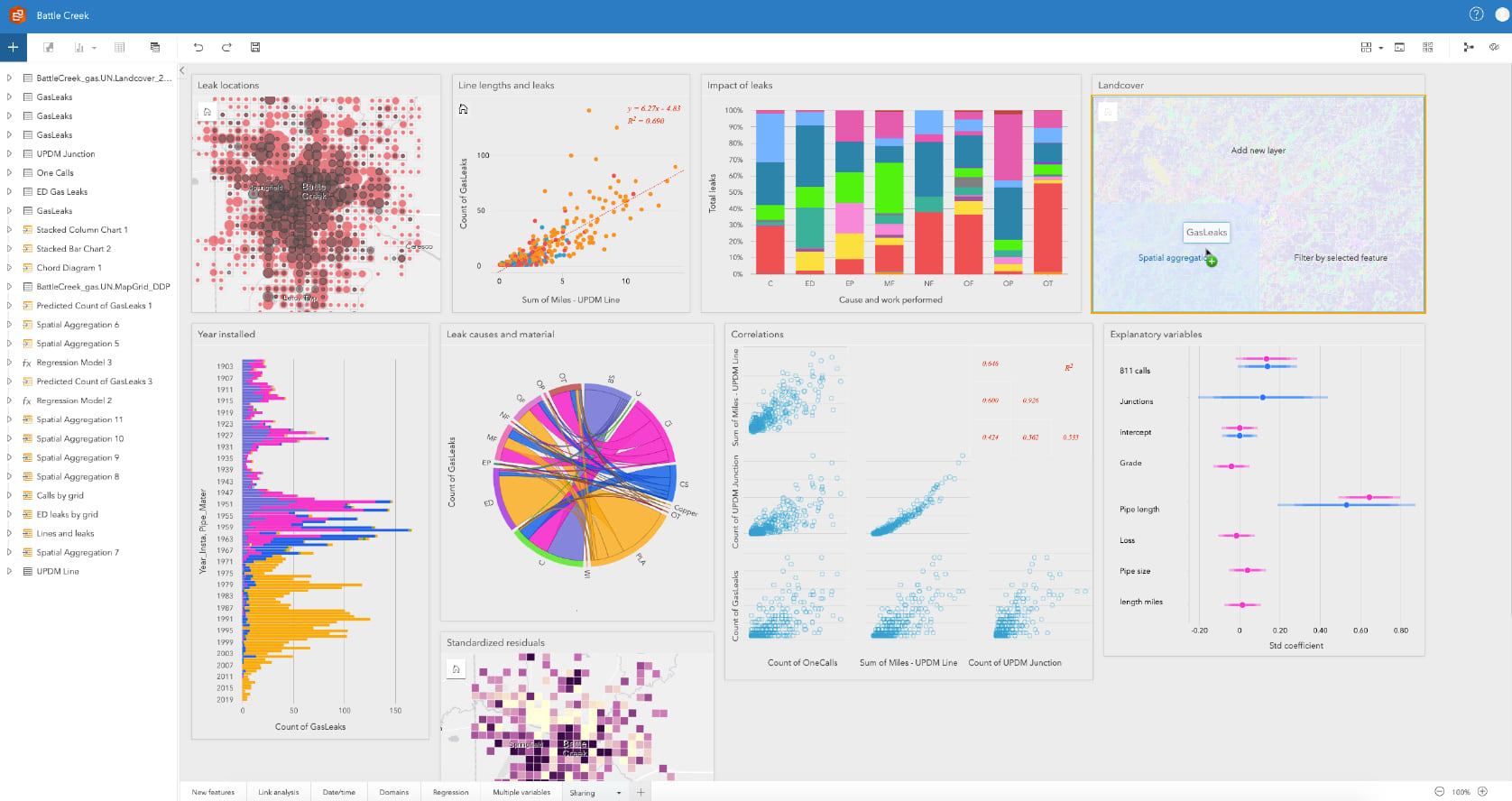
ArcGIS Insights
ArcGIS Insights is analysis software that fuses location analytics with open data science and business intelligence workflows. Explore data and perform advanced analytics such as spatial, statistical, predictive, and link analysis within a drag-and-drop user experience. Our latest release offers the following enhancements:
- New UI – Insights workbooks have a new look and feel. The same functionality you’ve become accustomed to is still there but, you’ll notice more screen real estate and a cleaner, simpler user experience.
- Unlimited data-only connections—Use Insights desktop to connect to ArcGIS Online and multiple ArcGIS Enterprise accounts. Every Insights desktop deployment must have one primary ArcGIS connection, and can have unlimited data-only connections.
- Domains and subtypes—Coded value domains and subtypes are now supported within Insights. If your feature class or feature layer has domains and subtypes Insights filters, cards, and widgets will honor these coded values. This will make it easier to understand how data is classified and categorized.
- Export data—It’s now easier than ever to get resulting analytical datasets out of Insights and shared with other people or other applications. With a one-click Export data option, simply export from the data pane. Exports can be shapefile, CSV, or GeoJSON format.
- Field calculations—New field calculations are available for date/time fields, including TIME() and TIMEDIF().
- Summary tables—Summary tables have been improved to make it easier to add, remove, and reorder fields.
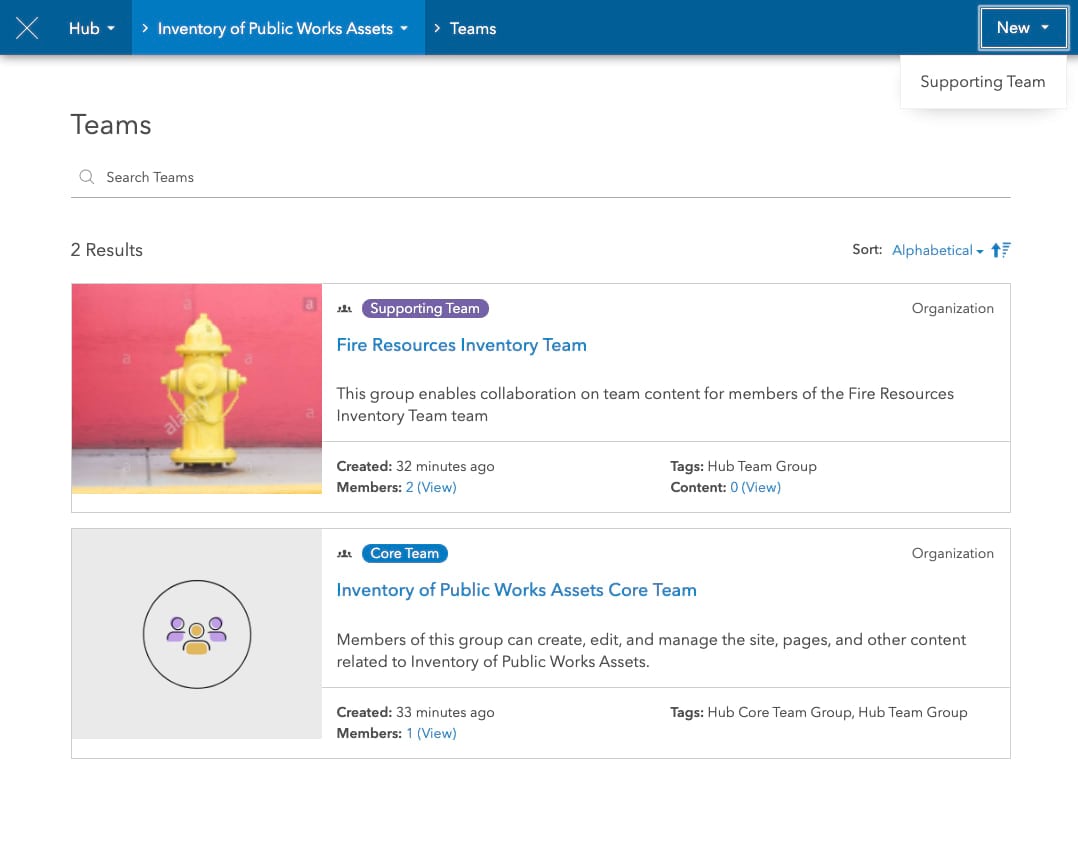
ArcGIS Hub
ArcGIS Hub is a cloud-based engagement platform that lets organizations work more effectively with their communities. Together, organizations and stakeholders can create informative and engaging digital content around any project, plan, event, or goal. Recent enhancements include:
- ArcGIS Hub is now in the app switcher and no longer requires an administrator to enable open data for your organization. This means that any ArcGIS Online member who has a Creator user type and has a Publisher role can now get quickly started creating sites and pages with ArcGIS Hub basic.
- Support for 3D maps: You can now add 3D web scenes to your sites and pages using the map card. 3D web scenes provide 3D models for showcasing a variety of scenarios, like proposed development, underground utilities, and more.
- Easier ways for administrators to configure their Hub’s sign-in experience. You can now add a trusted logo, a community support contact, and/or custom terms and conditions to your sign-in page.
- New ways to share and discover content.
- New features focused specifically on content management, aimed at reducing the amount of work it takes to create quality content on your initiatives and sites.
- Supporting Teams: A way to easily collaborate privately with a target group from your community!
These are just a few of the most recent enhancements. See the ArcGIS Blog for more details about what’s new in ArcGIS Hub.
ArcGIS Excalibur
ArcGIS Excalibur release includes broader support image services, improved project support, and introduces comparison workflow capabilities, and enhancements to portal.
Comparison workflows have been added—The new release of ArcGIS Excalibur V1.2 now includes two new tools (Swipe and Flicker) to facilitate comparison or change detection workflows.
Better project support—Support has been added to enable users to view existing project details. User will now have the option to edit text details of existing projects.
Greater support for image services—Support for viewing and working with a larger variety of image services (non-query enabled) is now included.
Increase in portal support—Enhancements across the application support for portal read only mode have been made to provide a better experience for the user.
ArcGIS Experience Builder
ArcGIS Experience Builder empowers you to transform your data into compelling web apps and web pages without writing a single line of code. Choose the tools you need from a rich set of widgets and templates, or build your own using the drag-and-drop builder. Experience Builder enables you to interact with 2D and 3D content within a single app and is built with flexibility and performance in mind. Since initial beta release in July 2019, we’ve received a lot of feedback and have made a number of enhancements and additions to the product. Experience Builder is out of beta. For more information, read this blog.
ArcGIS QuickCapture
With this update, we have added many new features into QuickCapture designer so you can create your projects more easily.
- User Inputs: allow you to prompt dialogs within the QuickCapture app so end-users can enter additional information during data capture. For more details, check our Understanding User Inputs in ArcGIS QuickCapture blog post.
- Continuous mode for point features: Up until this release, point features could be captured from QuickCapture one by one. That is, you would push the button, and the app would capture one point at that location. But now, when working in continuous mode, pushing the point button activates data capture for that feature as a stream. As you move, new points are captured.
- Optional photos: You can now configure your buttons to make capturing a photo required or optional.
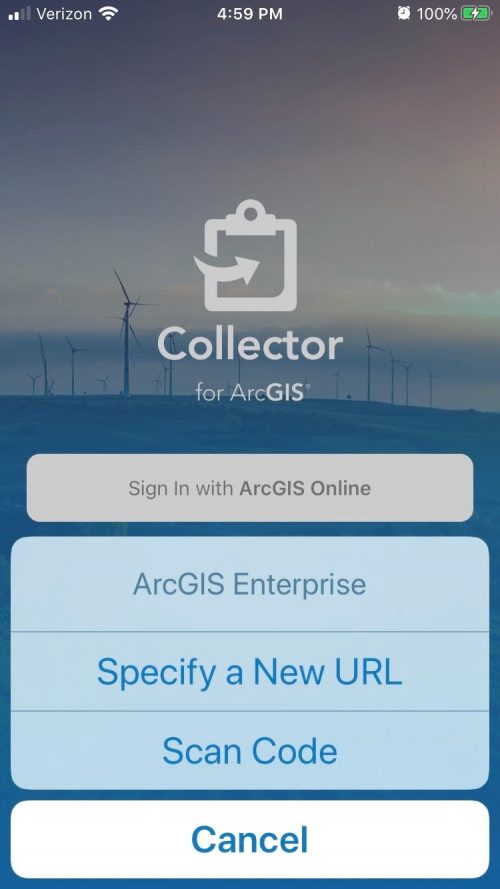
Collector for ArcGIS
Collector for ArcGIS is the premier mobile field data collection app that is used to add, edit, and update GIS data from the field. With it, field personnel use mobile devices to perform work in any environment, even when no Internet connection is available.
At Enterprise 10.8, we have delivered one of the most popularly requested enhancements from users – feature snapping. This capability, available for iOS users and coming soon for Android users, enables you to snap to existing point features or vertices of lines and polygons when using the map to create new features or when updating the location of existing ones. The user can control when snapping is enabled. Bulk form updating is a new efficiency enhancement that supports the updating of a form entry for multiple assets or observations at the same time.
When using maps offline, there is now the ability to create irregular offline areas (polygons) so users carry only the map areas they need, eliminating the distraction of irrelevant information. Sign in is now supported through a barcode or QR code that enables quick portal access. And, for mobile workers using Tracker for ArcGIS, track views are now accessible to display in Collector, allowing them to make sure they covered the required areas. Learn more about what’s new in Collector.
Explorer for ArcGIS
Explorer for ArcGIS is a simple, read-only map viewer app that allows users to take their maps with them wherever they go. Now available on iOS, updates for Android and Windows are coming soon!
The new version of Explorer brings many great improvements including new ways to more easily take maps offline, use raster imagery directly within mobile map packages, boost the situational awareness of mobile users with support for layer refresh intervals, and support for PKI-based authentication for greater data security. Learn more about what’s new in Explorer.
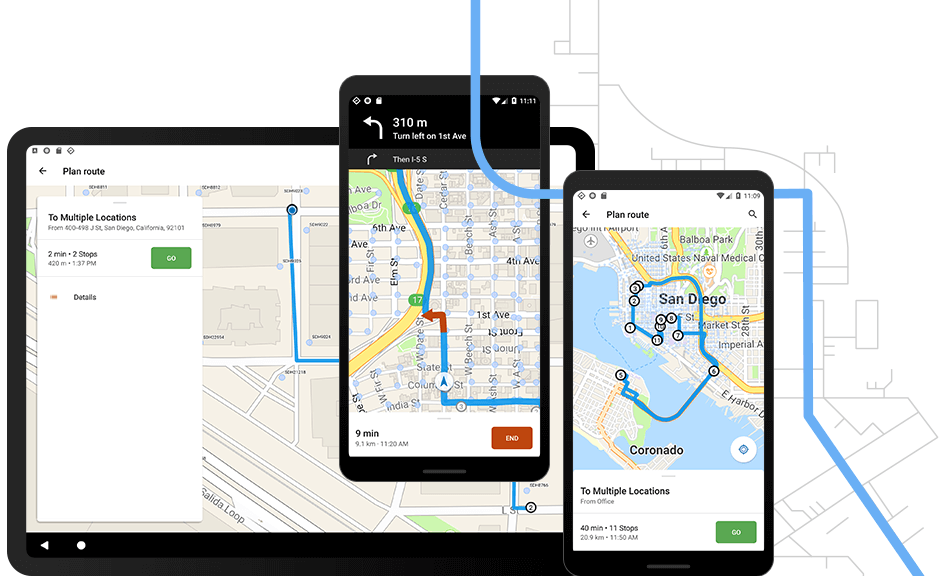
Navigator for ArcGIS
Navigator for ArcGIS is a mobile navigation app for Android and iOS that enables you to route your field workforce, delivering turn-by-turn, voice-guided directions for optimized routes. It comes with hundreds of global maps, and you can also add your own custom map. You can define travel modes, route using your own roads, and search your assets.
At Enterprise 10.8, Navigator supports the sharing of route layers with drivers directly in the Navigator app, providing time savings and assurance that even when connectivity is not available, access to routes will not be compromised. Also added is the ability to pause multi-stop routes without canceling routes entirely. In addition, drivers can now fully interact with features and assets on their Navigator maps and see complete attribute information, including media and attachments. Learn more about what’s new in Navigator.
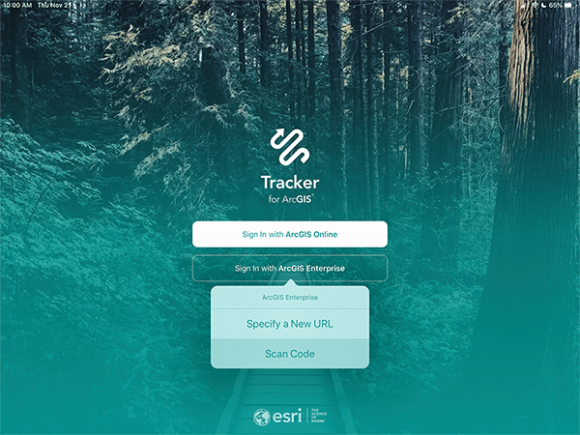
Tracker for ArcGIS
Know the real-time location of your most valued assets, your mobile workers. Tracker for ArcGIS is a mobile solution that enables organizations to capture the tracks of field staff, monitor where they are, and analyze where they have been. Tracker includes a mobile app for iOS and Android devices that efficiently runs in the background to capture location tracks.
The release of ArcGIS Enterprise 10.8 brings a streamlined process for provisioning the Track Viewer web app which is now embedded in Enterprise. Once the Administrator enables location tracking in the Enterprise organization, the Track Viewer web app will be accessible through the app switcher. This is a time saver over the prior process that required downloading of the app. The web app is used by an organization administrator to create track views, controlling who can see and use an individual’s location tracks. Those authorized, typically managers and supervisors, use the web app for the exploration, visualization, and interrogation of tracks.
Tracker for ArcGIS is a lightweight native mobile app for iOS and Android devices that is optimized for tracking user locations in the background with minimal impact on battery life. The mobile worker is in full control of when they are tracked and can set reminders to turn location tracking on and off. Learn more about what’s new in Tracker.
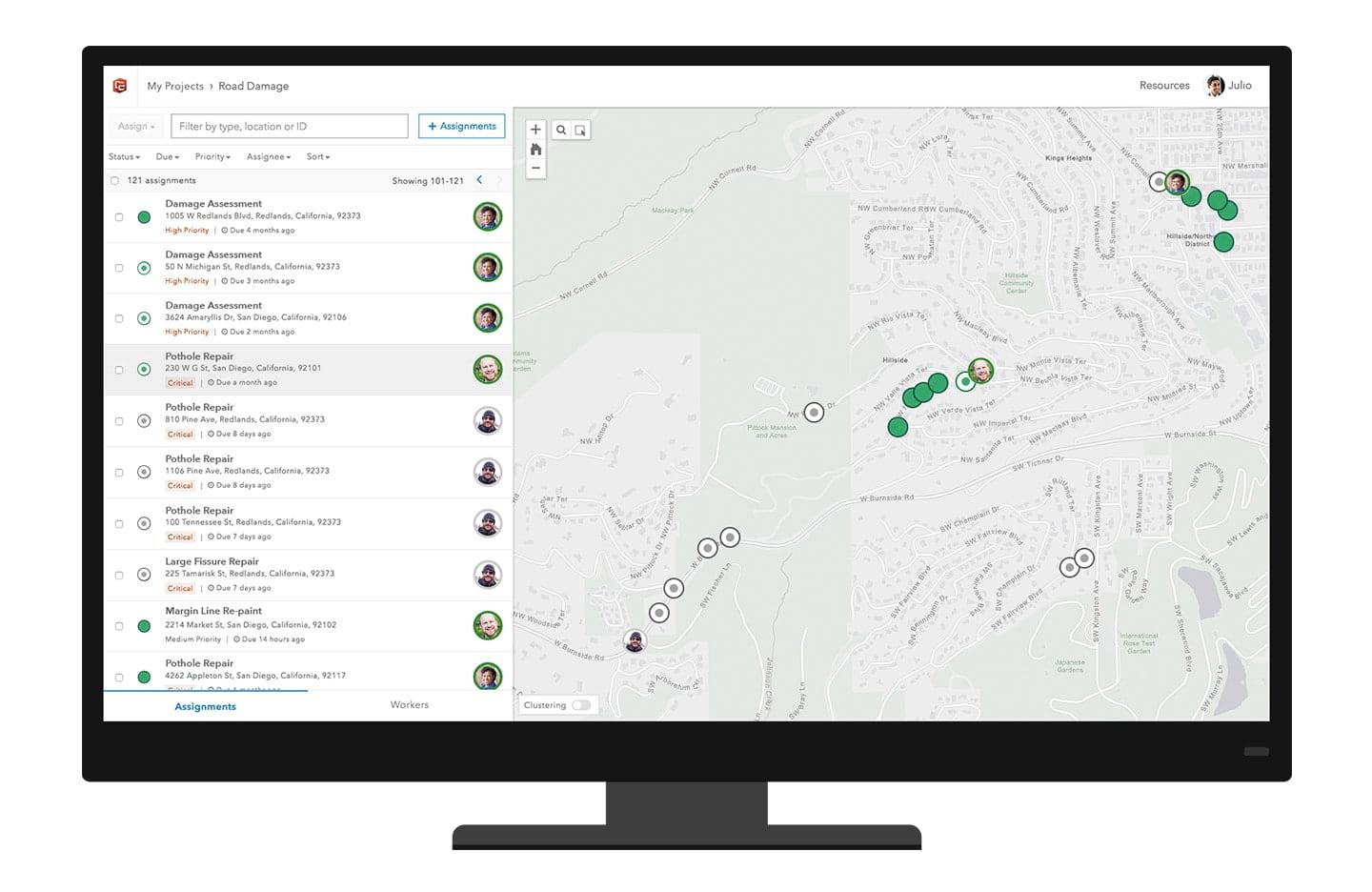
Workforce for ArcGIS
Increase transparency between the field and the office with Workforce for ArcGIS, a mobile app solution that enables the coordination of your field workforce. A web app is used to create projects and assign tasks to mobile workers who use a mobile app to receive and report on the status of their tasks.
With the Enterprise 10.8 release, the Workforce web app is now installed with ArcGIS Enterprise, no longer requiring a separate installation. Learn more about what’s new in Workforce.
ArcGIS StoryMaps
ArcGIS StoryMaps released in January and here’s a sampling of their latest capabilities.
- Guided tour
- Map actions
- Format text with color
- Fit and fill options for video
- Narrative panel style options in slideshow
- And more!
Storyteller User Type
A new user type, Storyteller, is available for anyone in your organization who only wants to build stories using ArcGIS StoryMaps. They can create stories using express maps, content from their organization, and multi-media content. Learn more about the Storyteller user type.
ArcGIS Earth
ArcGIS Earth, a free, lightweight, easy-to-use interface for immersive 3D experiences, now lets users edit KMLs and interact with a host of other data types, including web services. Users can leverage mobile scene packages and take content entirely offline as well, and support for QR codes now makes it easier and quicker share data from a desktop to a mobile device.

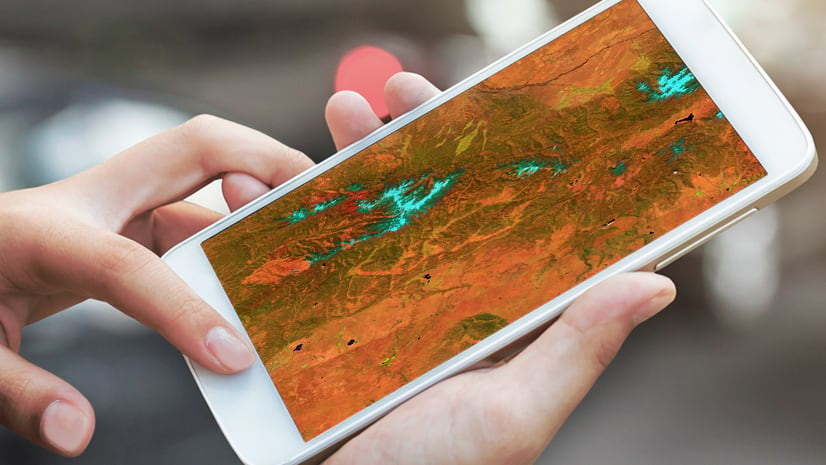

Commenting is not enabled for this article.